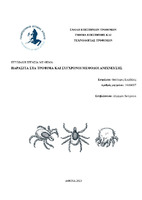| dc.contributor.advisor | HOUHOULA, DIMITRA | |
| dc.contributor.author | Καρβέλης, Θεόδωρος | |
| dc.date.accessioned | 2023-10-11T08:37:22Z | |
| dc.date.available | 2023-10-11T08:37:22Z | |
| dc.date.issued | 2023 | |
| dc.identifier.uri | https://polynoe.lib.uniwa.gr/xmlui/handle/11400/5270 | |
| dc.identifier.uri | http://dx.doi.org/10.26265/polynoe-5108 | |
| dc.description.abstract | Τα παράσιτα που επηρεάζουν τα τρόφιμα ταξινομούνται με βάση ένα χαρακτηριστικό, το αν παρασιτούν στα τρόφιμα και στους ξενιστές εξωτερικά ή εσωτερικά. Τα χωρίζουμε σε εσωπαράσιτα (Έλμινθες, πρωτόζωα), και σε εξωπαράσιτα (έντομα, παρασιτικά καρκινοειδή και τους μονογενείς εξωπαρασιτικούς έλμινθες).
Τα εσωπαράσιτα αποτελούν πρόβλημα κυρίως της πρωτογενούς παραγωγής, καθότι απαντώνται σε επιμολυσμένα νερά, στο χώμα και σε κόπρανα ζώων κατά κύριο λόγο. Ενώ τα εξωπαράσιτα μπορούν να αποτελέσουν θέμα δυνητικά σε όλη την αλυσίδα παραγωγής.
Οι τάσεις για τα παράσιτα στις διάφορες κατηγορίες τροφίμων περιλαμβάνουν κατά κύριο λόγο τα πρωτόζωα Toxoplasma gondii, Giardia lambia, και Cryptosporidium parvum, Cyclospora spp., καθώς και τους έλμινθες Trichinella spiralis, Taenia solium, Taenia saginata, και Anisakis spp.
Τρόφιμα υψηλού κινδύνου αποτελούνται κυρίως από τα κρέατα και κρεατοσκευάσματα, και συγκεκριμένα ότι περιέχει χοιρινό κρέας καθώς παρουσιάζει μεγάλο εύρος παρασιτώσεων τόσο από πρωτόζωα όσο και από έλμινθες. Από τα ιχθυηρά, όλα τα ψάρια, καρκινοειδή και οστρακοειδή μιας και πολλά παράσιτα, συγκεκριμένα οι έλμινθες, τα πρωτόζωα και κάποια εξωπαρασιτικά καρκινοειδή, ξεκινούν και ολοκληρώνουν τον κύκλο της ζωής τους σε αυτά.
Το νερό έχει ιδιαίτερο ενδιαφέρον είτε ως προϊόν, είτε ως πρώτη ύλη στην βιομηχανία τροφίμων εις ότι αφορά τα παράσιτα καθώς είναι συνήθης φορέας πολλών εκ των τροφιμογενών παράσιτων.
Οι παραδοσιακές μέθοδοι ανίχνευσης των παρασίτων περιλαμβάνουν μεθόδους ιστολογικές και χρώσης με παρατήρηση στο μικροσκόπιο και παρόλο του εξακολουθούν να είναι χρήσιμες σε επίπεδο διάγνωσης και περιβαλλοντικού ελέγχου, η χρήση τους άμεσα στα τρόφιμα καθ’αυτά είναι περιορισμένη.
Οι σύγχρονες μέθοδοι ανίχνευσης των παράσιτων χωρίζονται σε τρεις κατηγορίες, στις μεθόδους με χρήση βιοδεικτών, στις ανοσολογικές μεθόδους με γνώμονα την σχέση αντισώματος-αντιγονικού καθοριστή, και τις διάφορες μεθόδους ενίσχυσης βιολογικών μακρομορίων (DNA – RNA). | el |
| dc.format.extent | 30 | el |
| dc.language.iso | el | el |
| dc.publisher | Πανεπιστήμιο Δυτικής Αττικής | el |
| dc.rights | Αναφορά Δημιουργού - Μη Εμπορική Χρήση - Παρόμοια Διανομή 4.0 Διεθνές | * |
| dc.rights | Attribution-NoDerivatives 4.0 Διεθνές | * |
| dc.rights | Αναφορά Δημιουργού 4.0 Διεθνές | * |
| dc.rights.uri | http://creativecommons.org/licenses/by/4.0/ | * |
| dc.subject | Παράσιτα | el |
| dc.subject | Τροφιμογενή παράσιτα | el |
| dc.subject | Τρόφιμα | el |
| dc.subject | Μέθοδοι ανίχνευσης | el |
| dc.title | Παράσιτα στα τρόφιμα και σύγχρονοι μέθοδοι ανίχνευσης | el |
| dc.title.alternative | Foodborne parasites and modern methods of detection | el |
| dc.type | Πτυχιακή εργασία | el |
| dc.contributor.committee | Kanellou, Anastasia | |
| dc.contributor.committee | Αντωνόπουλος, Διονύσιος | |
| dc.contributor.faculty | Σχολή Επιστημών Τροφίμων | el |
| dc.contributor.department | Τμήμα Επιστήμης και Τεχνολογίας Τροφίμων | el |
| dc.description.abstracttranslated | Parasites are firstly classified based on one characteristic, whether they parasitize the host from the inside or the outside. We group them into internal parasites (Helminths, Protozoa), and ectoparasites (bugs, crustaceans ectoparasites and monogenean ectoparasitic helminths).
Internal parasites are a concern mainly for the primary production, as they are usually found in contaminated water, dirt and animal feces, whereas ectoparasites can show up during any stage of the production chain.
Parasite trends in the various food categories include mainly the protozoa Toxoplasma gondii, Giardia lambia, and Cryptosporidium parvum, Cyclospora spp., and the helminths Trichinella spiralis, Taenia solium, Taenia saginata, and Anisakis spp.
High-risk foods consist mainly of meats and meat products, and specifically those that contain pork as it presents a wide range of parasitic infestations by both protozoa and helminths. Also, all of the seafood such as fishes, crustaceans and shellfish are of great import since many parasites, namely helminths, protozoa and some ectoparasitic crustaceans, start and complete their life cycle using them as hosts.
Water is of particular interest either as a product or as a raw material in the food industry in terms of parasites as it is a common carrier of many of the foodborne parasites.
The traditional parasite detection methods include histological and staining methods alongside observation under the microscope, and although they are still useful nowadays, at the level of diagnosis and environmental control, their use directly in foodstuffs is limited.
Modern parasite detection methods are divided into three categories, the methods using biosensors, the immunological methods based on the antibody-antigenic determinant relationship, and the various methods of amplifying biological macromolecules (DNA – RNA). | el |


